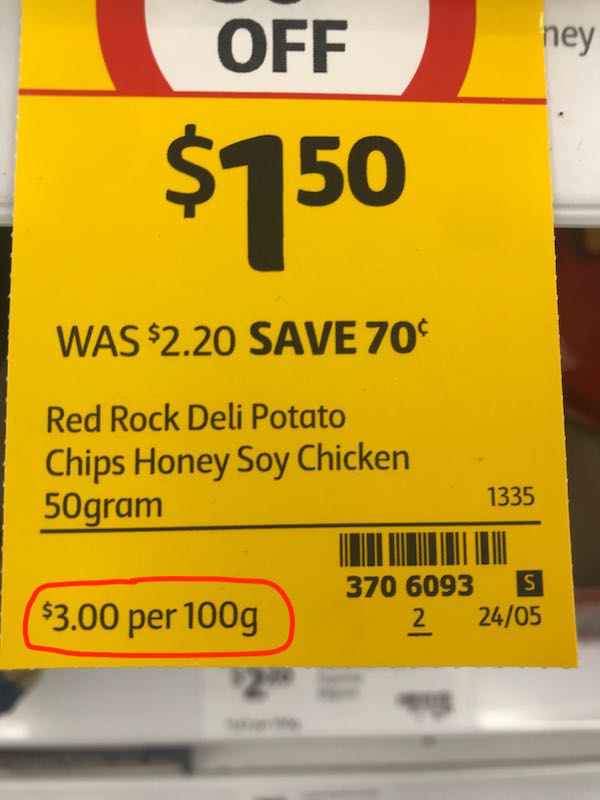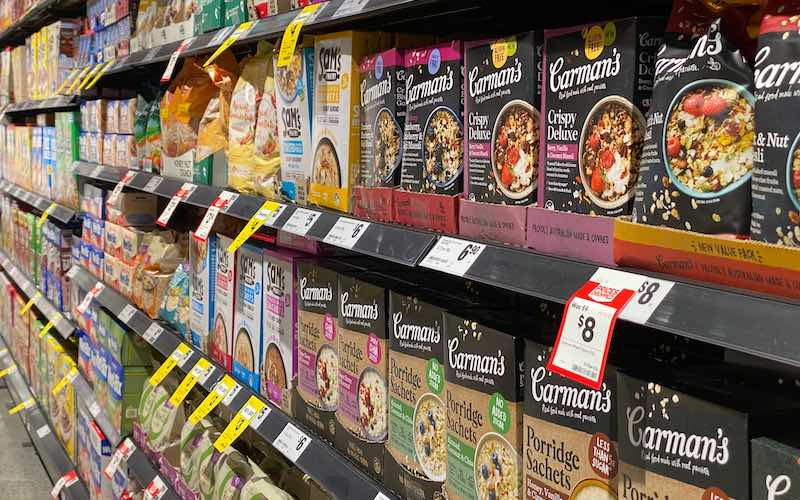When things shrink, we tend to be disappointed (I was in the pool!). Manufacturers and supermarket giants know that increasing the price of essential items like food is a cause for frustration amongst their customers, so instead they sometimes keep the price the same but reduce the volume.
Professor Gary Mortimer, Consumer Behaviour Researcher and Retail Expert from the QUT Business School, told Savings.com.au how shrinkflation works.
“Shrinkflation is simply a contents reduction strategy, in which brand manufacturers place less contents be that potato chips or chocolate or cereal into the box or the container, but charge the same price,” Dr Mortimer said.
“Therefore, customers essentially pay the same, but just get a little less.”
Why does shrinkflation happen?
Shrinkflation is a trickle-on effect of the rising costs of good and services. Petrol prices have surged past $2 per litre, and transport costs have risen 13.7% on an annualised basis. Overall inflation has risen to 5.1% - the highest in decades.
As the cost of petrol increases, transport costs increase and therefore, the cost of producing biproducts increases, and those costs are passed on to the customer.
“As input cost increase - that's the cost of beef, the cost of wheats in grains and bread rolls, fuel costs increas[ing] - you may find that you're getting fewer chips on the plate. Maybe the burger has shrunk in size a little bit, or the pizza has shrunk in size a little bit,” Dr Mortimer said.
Advertisement
Need somewhere to store cash and earn interest? The table below features savings accounts with some of the highest interest rates on the market.

- Bonus variable rate for the first 4 months on balances up to $250k and high variable ongoing rates.
- No fees and no monthly requirements to earn interest.
- Easily open an account online in 3 minutes.
Which brands have ‘shrinkflated’?
According to Dr Mortimer, many well-known brands have reduced their product sizes.
“We've seen a number of brands over the years engage in shrinkflation as input costs increase,” he said.
“Arnott's reduced the contents of their chocolate biscuits, particularly Tim Tams. We've seen Kellogg's also reduced the contents of their cereal. Cadbury more famously reduced the size of their family blocked chocolates. Smith's and Lay's chips reduced the packets of chips from 250, down to 200 grams, down to 175 grams.
“We see it across the board. I think what we're also going to start to see is dry groceries - things like laundry detergent - going from a one kilo pack size to 900 grams, or even toilet paper shrinking.”
Also read: How inflation impacts you
Shrinkflation vs Inflation
In Australia, the cost of goods and services will typically increase over time. This is called inflation, and it’s the reason a can of coke cost 10c in 1970, but will cost you a couple of dollars now. This is also the case with larger expenses like petrol, cars and even property.
Inflation has been the talk of the town to start 2022, as the cost of these every day items has been rising at a faster rate than wages growth, and savings accounts.
In the United States, food costs have already risen 12% on an annualised basis.
Alberto Cavallo, associate professor of business administration at Harvard Business School, said this is due to supply shortages and the war in Ukraine.
“The acceleration in food inflation and renewed supply disruptions continue to put upward pressure on prices. It is unclear how long these pressures will last, making it all the more important for policymakers to understand the current real-time dynamics of price trends,” Mr Cavallo said.
On the other hand, shrinkflation is when the cost of an item stays the same, but the amount in a packet or box, reduces.
According to Dr Mortimer, Aussies actually prefer shrinkflation and would rather pay the same but get a little less than pay more money.
“Myself and some colleagues found in our research that customers prefer to pay the same but get a little less to avoid having to pay more for the same. So in fact, customers don't mind shrinkflation; it's an alternative way to save money,” he said.
Food price rises since 2019 pic.twitter.com/oHFZxHyX0B
— ☔Jason Murphy (@jasemurphy) February 2, 2022
How to keep an eye on shrinkflation
If you are worried about paying the same but getting less bang for your buck, Dr Mortimer said to look for the unit price (pictured below).
“I guess the only way is to keep an eye on the unit price, which is the small secondary price on most shelf tickets in supermarkets. You'll notice if the contents reduces, but the retail price remains the same, that price tends to go up,” he said.
“When it comes to restaurants and fast service, like McDonald's and Hungry Jack's, it's a little bit more difficult to determine if the burger or the pizza has gotten smaller.”

Photo by Aaron Bell.
Photo by Franki Chamaki on Unsplash








 Denise Raward
Denise Raward

 Harry O'Sullivan
Harry O'Sullivan
 Brooke Cooper
Brooke Cooper
 Rachel Horan
Rachel Horan

